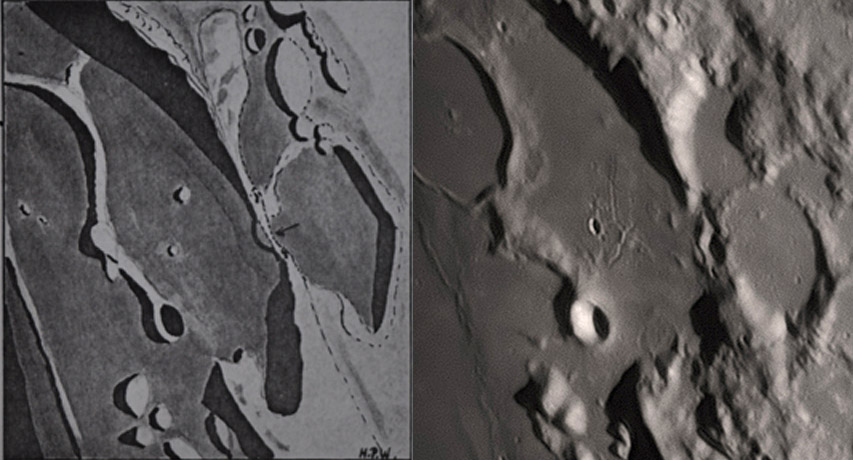October 15, 2023
A Bridge Too Far, an Observation Quite Good
Originally published September 30, 2013

image by Leo Aerts
On August 27th 1953 H.P. Wilkins made this drawing of O’Neill's bridge, and 60 years later Leo imaged the same area. The image, which I accept as the truth, shows that in general the sketch was pretty accurate in depicting the large scale features; the mountain ridges and large craters are well shown. But look at the two small hills near the center of Wilkins's drawing. The smaller one is actually an impact crater and the larger one is a very low, non-bright plateau of older terrain; the rilles are not depicted at all. Now look at the very sharply defined shadow of the bridge. Leo's image suggests that what Wilkins saw as the bright rounded area under the bridge was probably the illuminated rim of a small crater - well seen on LRO Quickmap - and that the thin curved shadow of the rim was what Wilkins drew as the bridge. In this light the observation and drawing are quite good, but the interpretation was completely bizarre. Perhaps in the 1950s when the flying saucer craze was real, and when Wilkins himself wrote silly books about space, the interpretation as a bridge might have jumped to his mind. But the fact is that the interpretation outraged other leading members of the British Astronomical Association and led to his ouster as director of the Lunar Section. The descendants of the Wilkins who saw a bridge are the credulous people who see faces on Mars and cities on the Moon. The successors of the Wilkins who quite accurately depicted at least some subtle details at the limits of resolution are the observers who push every last photon of excellence from their imaging.
Chuck Wood
Technical Details
July 25th 2013, 02:12 UT. Celestron 14, 1.8x barlow projection, redfilter and use of dispersion corrector.
Related Links
21st Century Atlas chart 2.
Yesterday's LPOD: Almost Microgeology
Tomorrow's LPOD: West View
COMMENTS?
Register, Log in, and join in the comments.



